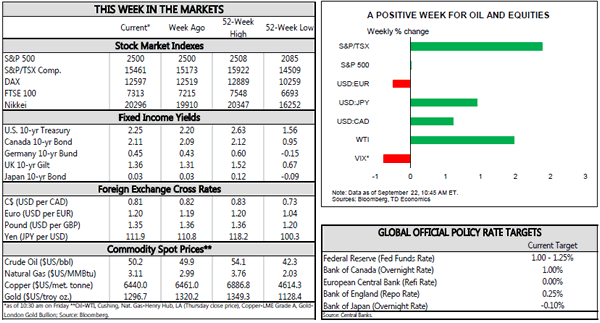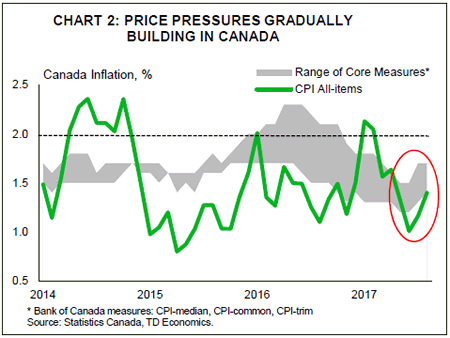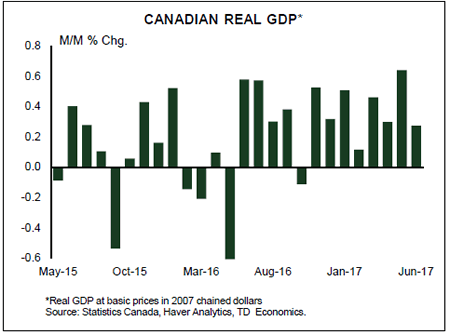U.S. Highlights
- Finally, midway through 2017 global growth is looking better than it was a few months ago. Our latest Global Outlook discusses how the optimism that has been missing for several years has finally returned.
- With stronger global growth comes tighter monetary policy. This week the Fed formally took the next step of starting to reduce the size of its balance sheet.
- The Fed also reaffirmed that it expects to hike rates again this year. Our U.S. Outlook looks solid over the next two years, despite the hit from the devastating hurricanes. Reduced economic slack should lead to higher inflation, consistent with a gradual pace of rate hikes over the next two years.
Canadian Highlights
- The data flow this week remained broadly consistent with our updated view that the Canadian economy is likely to maintain above-trend growth in the third quarter.
- On balance, wholesale activity for July provided some upside risk to our outlook for third quarter growth, while retail and manufacturing sales volumes were less supportive. On the price side, headline and underlying measures of inflation rose slightly in August, suggesting that prices may have finally stabilized after a soft spell.
- Overall, we anticipate that the persistence of above-trend economic growth will likely motivate the Bank of Canada to push up rates by another 25 bps before the end of the year.

U.S. – We’ve Got To Admit Its Getting Better
In recent years, economic growth forecasts have suffered from serial disappointment. Economic outlooks have typically been downgraded part way through the year, but not so this time. Our latest Global Outlook discusses how a broadening and strengthening of expansions in advanced and emerging economies has helped restore a sense of optimism in the global economy that has been missing for several years.
Global growth is on track to average 3.5% this year, and over the next two years. Highly accommodative monetary policy has done its job in sowing the seeds for self-sustaining economic growth across a number of regions. Now, with economic slack being absorbed at a faster clip, central banks are increasingly scaling back that stimulus. In the Euro Area, real GDP growth of 2.4% in the first half of the year was faster than expected, and nearly double the economy’s estimate of trend growth. As a result, the European Central Bank looks set to announce an end to its asset purchases at its upcoming meeting in October.
The Federal Reserve is further along in reducing monetary stimulus, with four rate hikes under its belt. This week it formally announced that it will start reducing the size of its $4.4 trillion balance sheet in October. The pace will be very gradual, with the monthly runoff amounting to 0.2% of its balance sheet. The process was already laid out clearly in June, and as such there was little reaction in the longer end of the curve.
Markets paid greater attention to the Fed’s message on future rate hikes, and how that may have changed given the softness in inflation this year. Yellen acknowledged that not all of the weakness in inflation can be chalked up to transitory factors (as we discussed in our latest forecast). However, interest rate projections for the near-term were left unchanged. The median expectation of Fed members is for one more hike this year and three hikes in 2018. Confirmation that the Fed hasn’t lost its faith in the Phillips curve did produce an upward move in shorter-term yields. And, the odds on a rate hike in December have shifted from a coin flip to being roughly two-thirds priced in.
The Committee also indicated that recent hurricanes are likely to impact inflation and economic activity in the near term, disrupting it first and then boosting it thereafter as rebuilding begins. However, the storms are "unlikely to materially alter the course of the national economy over the medium term." As such, we expect the Fed to see through any of the volatility in the data over the coming months, with the storms unlikely to prevent the Fed from potentially raising rates at their December meeting – particularly if inflation data firms as we expect.
Overall, the U.S. economy is expected to continue its "Steady-Eddie" performance of slightly better than 2% growth over the next few years. Upside and downside risks to this outlook remain: either from a fiscal boost from Washington or from delayed capital spending due to policy uncertainty on taxes or NAFTA renegotiation.


Canada – A Little More Sizzle Before the Fizzle
The data flow this week remained broadly consistent with our view that the Canadian economy is set to expand at a robust, above-trend pace in the third quarter.
Consumer spending thus far has been very robust, supported by past gains in wealth and job growth. Retail sales have performed particularly well, with volumes rising every month this year through June. Given this hot streak it should come as no surprise that consumers took a break in July. This morning’s retail data showed improvement in sales driven by higher prices, as volumes fell 0.2% on a month-on-month basis. Overall, the data is broadly consistent with our view that Canadian households are likely to scale back spending in the second half of the year as higher interest rates start to bite and housing activity moderates.
Other activity data this week were mixed, but the upside risk to growth from wholesale trade edges out any downside from manufacturing sales. On the latter, manufacturing sales for July were disappointing as volumes fell 1.4% and growth in prior months was revised down. However, some of the weakness in the month may be due to an unusually long retooling-related shutdown of vehicle assembly plants in the month, suggesting a possible rebound in August as plants come back on line. But, with forward-looking indicators down in the month, it looks as if the Canadian manufacturing sector could cool a bit in the third quarter.
More positively, Canadian wholesalers recorded a 2.1% jump in volumes in July, the largest monthly increase yet this year. Strong sales by building material and supplies distributors, machinery and equipment suppliers, and clothing distributors helped drive the advance. Overall, this uptick in wholesale activity presents a material upside risk to our 2.3% tracking of third quarter GDP growth (Chart 1).
All told, the Canadian economy is on pace to expand at an above-trend pace of about 2.5% in the third quarter. This remains broadly consistent with our updated outlook published mid-week, which anticipates a slowdown in activity in the second half after the sizzling pace.
On the price side of things, CPI data for August remained broadly supportive of our outlook (Chart 2). Headline and underlying inflation measures all ticked up in the month, providing some justification for the two 25 bp rate hikes in the span of six weeks by the Bank of Canada. Looking ahead, the rapid appreciation of the loonie is likely to shave about 0.3 percentage points off of quarterly price growth by the start of next year. However, the Bank of Canada is likely to look through this weakness, deeming it as largely another temporary factor acting to keep price pressures subdued. Instead, as highlighted in Deputy Governor Tim Lane’s speech this week, the Bank will remain focused on how the Canadian economy adapts to higher interest rates and a higher dollar. Overall, we anticipate that the persistence of above-trend economic growth will likely motivate the Bank of Canada to push up rates by another 25 bps before the end of the year.


U.S.: Upcoming Key Economic Releases
U.S. Personal Income & Spending – August
Release Date: September 29, 2017
Previous Result: Income 0.4% m/m, Spending 0.3% m/m
TD Forecast: Income 0.2% m/m, Spending 0.1% m/m
Consensus: 0.2% m/m, Spending 0.1% m/m
Headline PCE inflation is expected to firm to 1.5% in August, reflecting a 0.3% rise in prices on the month. Driving the August pickup are energy prices, led by higher gasoline prices amid the Hurricane Harvey disruption. In line with the CPI report, we expect the core (ex food & energy) index to post a 0.2% m/m increase, its first since February. Unrounded, however, the monthly gain should be more modest than its CPI counterpart due to different weightings for housing and medical care in particular. As a result, we expect core PCE inflation to be unchanged at 1.4% y/y. However, this should mark the bottom of the cycle, barring disappointment in future readings. Overall, the return to a healthier 0.2% m/m rise in the core PCE should comfort the Fed’s inflation outlook in offering an early sign that transitory effects are fading and underlying strength is building.
Nominal PCE (personal spending) is expected to rise 0.1% in August, relatively weak again reflecting the Harvey impact that dented motor vehicle sales in particular. The gain would be consistent with Q3 real PCE tracking just below a 2.0% pace, a downgrade from our earlier estimates primarily due to the hurricane impacts. With the impacts expected to unwind by Q4, the Fed will look through this as a one-off shock. We also expect a 0.2% increase in August personal income, based on the weaker than expected 0.1% rise in average hourly earnings.

Canada: Upcoming Key Economic Releases
Canadian Real GDP – July
Release Date: September 29, 2017
Previous Result: 0.3% m/m
TD Forecast: 0.1% m/m
Consensus: N/A
A sizeable drag from the manufacturing industry will constrain GDP growth to 0.1% m/m in July. Real manufacturing sales fell due to extended shutdowns at Canadian auto plants, but the transitory nature implies a rebound in August. Outside of auto production, the performance of the goods sector should be relatively mixed. Energy output could see further gains due to increased production at the Syncrude upgrader facility, which had been operating at a reduced capacity following an explosion earlier this year, but we see downside risks to residential construction. Services should be fairly mixed as the ongoing slowdown in housing and a modest decline in real retail sales will offset a surge in wholesale sales. Our forecast for a 0.1% gain in July is consistent with Q2 growth in the mid-2% range, which is still above estimates from the July MPR even though it represents a significant slowdown from Q2.












